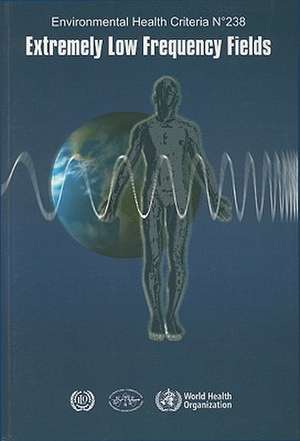Extremely Low Frequency Fields: Environmental Health Criteria, cartea 238
Editat de World Health Organizationen Limba Engleză Paperback – 30 noi 2007
Din seria Environmental Health Criteria
-
 Preț: 159.75 lei
Preț: 159.75 lei -
 Preț: 220.46 lei
Preț: 220.46 lei - 5%
 Preț: 296.49 lei
Preț: 296.49 lei - 5%
 Preț: 149.15 lei
Preț: 149.15 lei -
 Preț: 313.02 lei
Preț: 313.02 lei - 5%
 Preț: 157.30 lei
Preț: 157.30 lei - 5%
 Preț: 208.73 lei
Preț: 208.73 lei - 5%
 Preț: 148.45 lei
Preț: 148.45 lei - 5%
 Preț: 168.81 lei
Preț: 168.81 lei - 5%
 Preț: 154.98 lei
Preț: 154.98 lei - 5%
 Preț: 304.47 lei
Preț: 304.47 lei - 5%
 Preț: 246.20 lei
Preț: 246.20 lei - 5%
 Preț: 181.30 lei
Preț: 181.30 lei - 5%
 Preț: 397.75 lei
Preț: 397.75 lei - 5%
 Preț: 135.95 lei
Preț: 135.95 lei - 5%
 Preț: 155.75 lei
Preț: 155.75 lei - 5%
 Preț: 122.13 lei
Preț: 122.13 lei - 5%
 Preț: 122.13 lei
Preț: 122.13 lei - 5%
 Preț: 206.71 lei
Preț: 206.71 lei - 5%
 Preț: 156.11 lei
Preț: 156.11 lei - 5%
 Preț: 130.66 lei
Preț: 130.66 lei - 5%
 Preț: 303.74 lei
Preț: 303.74 lei - 5%
 Preț: 122.34 lei
Preț: 122.34 lei - 5%
 Preț: 191.03 lei
Preț: 191.03 lei - 5%
 Preț: 156.11 lei
Preț: 156.11 lei - 5%
 Preț: 168.61 lei
Preț: 168.61 lei - 5%
 Preț: 191.57 lei
Preț: 191.57 lei - 5%
 Preț: 189.35 lei
Preț: 189.35 lei - 5%
 Preț: 246.06 lei
Preț: 246.06 lei - 5%
 Preț: 189.35 lei
Preț: 189.35 lei - 5%
 Preț: 135.95 lei
Preț: 135.95 lei - 5%
 Preț: 155.55 lei
Preț: 155.55 lei - 5%
 Preț: 102.73 lei
Preț: 102.73 lei -
 Preț: 313.02 lei
Preț: 313.02 lei -
 Preț: 345.10 lei
Preț: 345.10 lei -
 Preț: 219.95 lei
Preț: 219.95 lei - 5%
 Preț: 239.54 lei
Preț: 239.54 lei - 5%
 Preț: 425.51 lei
Preț: 425.51 lei -
 Preț: 263.51 lei
Preț: 263.51 lei - 5%
 Preț: 168.72 lei
Preț: 168.72 lei - 5%
 Preț: 209.43 lei
Preț: 209.43 lei - 5%
 Preț: 494.77 lei
Preț: 494.77 lei - 5%
 Preț: 460.12 lei
Preț: 460.12 lei - 8%
 Preț: 580.98 lei
Preț: 580.98 lei - 5%
 Preț: 157.14 lei
Preț: 157.14 lei - 5%
 Preț: 150.81 lei
Preț: 150.81 lei - 5%
 Preț: 292.48 lei
Preț: 292.48 lei - 5%
 Preț: 252.19 lei
Preț: 252.19 lei - 5%
 Preț: 285.19 lei
Preț: 285.19 lei - 5%
 Preț: 638.13 lei
Preț: 638.13 lei
Preț: 414.96 lei
Preț vechi: 436.80 lei
-5% Nou
Puncte Express: 622
Preț estimativ în valută:
79.40€ • 82.91$ • 65.57£
79.40€ • 82.91$ • 65.57£
Carte indisponibilă temporar
Doresc să fiu notificat când acest titlu va fi disponibil:
Se trimite...
Preluare comenzi: 021 569.72.76
Specificații
ISBN-13: 9789241572385
ISBN-10: 9241572388
Pagini: 519
Dimensiuni: 142 x 208 x 38 mm
Greutate: 0.78 kg
Editura: WORLD HEALTH ORGN
Seria Environmental Health Criteria
ISBN-10: 9241572388
Pagini: 519
Dimensiuni: 142 x 208 x 38 mm
Greutate: 0.78 kg
Editura: WORLD HEALTH ORGN
Seria Environmental Health Criteria
